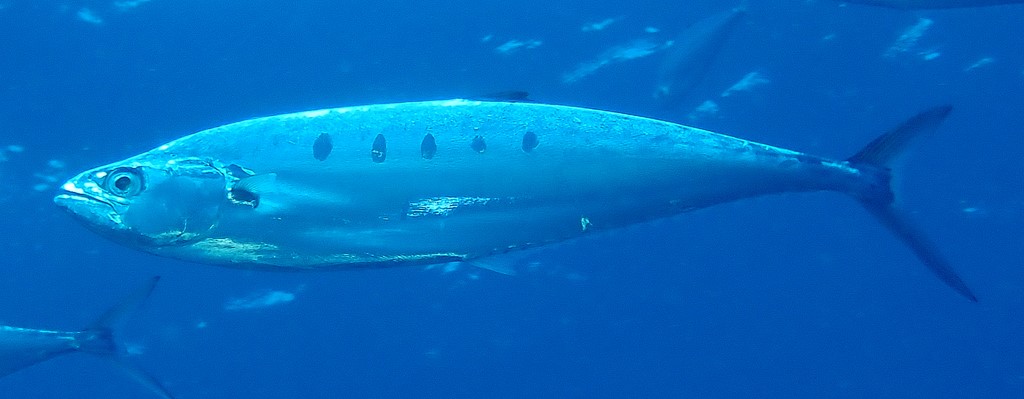SCOMBEROIDES TOL - (CUVIER, 1832)
Picture courtesy of: Alain Daoulas
Actinopterygii (Gigaclass) > Actinopteri (Class) > Teleostei (Subclass) > Carangiformes (Order) > Carangoidei (Suborder) > Carangidae (Family) > Scomberoidinae (Subfamily) > Scomberoides (Genus)
Sauteur leurre, Blackfin queenfish, Needleskin queenfish, Needlescaled queenfish, Slender leatherskin, Needle-qcaled queenfish, Naaldskub-koninginvis, Jurel saltarín, قفّاز رامج, Minami-ikekatsuo, ミナミイケカツオ, 台湾鰆鲹, 托爾逆溝鰺,
Actinopterygii (Gigaclass) > Actinopteri (Class) > Teleostei (Subclass) > Carangiformes (Order) > Carangoidei (Suborder) > Carangidae (Family) > Scomberoidinae (Subfamily) > Scomberoides (Genus)
Sauteur leurre, Blackfin queenfish, Needleskin queenfish, Needlescaled queenfish, Slender leatherskin, Needle-qcaled queenfish, Naaldskub-koninginvis, Jurel saltarín, قفّاز رامج, Minami-ikekatsuo, ミナミイケカツオ, 台湾鰆鲹, 托爾逆溝鰺,
Synonymes
Chorinemus tol (Cuvier, 1832)
Scomberoides formosanus (Wakiya, 1924)
Scomeroides tol (Cuvier, 1832)
--------------------------
Description
Dorsal spines (total): 7-8; Dorsal soft rays (total): 19-21; Anal spines: 3; Anal soft rays: 18-20; Pectoral fin rays: I + 16-17; Gill rakers: 4-7 + 17-20 = 21-26; Vertebrae: 10 + 16 = 26. Body strongly compressed, oblong and elliptical, dorsal and ventral profiles equally convex; Lateral line slightly arched above pectoral fin. Upper jaw extending to posterior edge of pupil in adults; Dentary with two teeth rows separated by a shallow groove in adults, teeth in both rows almost same size. Body covered with slender, needle-like scales; No scutes along lateral line. Soft rays of posterior dorsal and anal fins consist of semi-detached finlets. Max. length: 60.0 cm TL, common length: 40.0 cm TL. Depth range: 0 - 50 m, usually 20 - 50 m.
Color
A bluish-green to bluish-grey queenfish becoming silvery white below, with 5-8 vertically elongate or dark oval spots along the side, the first 4-5 intersecting the lateral line, a black outer half on the dorsal fin lobe, and a white anterior lobe on the anal fin.
Etymology
Scomberoides: from Latin, scomber = mackerel + fron Latin prefix, –oides = having the form of. Referring to its presumed close affinity with “true” mackerels, Scomber (Scombriformes: Scombridae).
tol: from Tol Parah = local name for this species at Vizagapatam, India, Bay of Bengal, as reported by Russell (1803).
Original description: Chorinemus tol Cuvier, 1832 - Type locality: Malabar coast, India, Arabian Sea, western Indian Ocean.
Distribution
Indo-West Pacific: Eastern Cape and KwaZulu-Natal (South Africa), East Africa, Socotra (Yemen), Persian Gulf and Madagascar east to Philippines and Marquesas Islands (French Polynesia), north to southern Korea and southern Sea of Japan (Korea, Japan), south to Exmouth Gulf (Western Australia), Queensland (Australia), New Caledonia and Tonga.
Biology
Adults are found near the surface in coastal waters, in small schools. Adults mainly consume fishes, while juveniles use specialised rasping teeth to feed on the scales and epidermal tissues of other fishes. Dorsal and anal fins may carry toxins. Targeted by commercial and recreational fishers. Throughout its range, this species is taken using drift set nets, gill nets, seines and hook and line, and is mainly marketed fresh; Also used as baitfish in some areas.
Similar species
Scomberoides lysan (Fabricius, 1775) - Reported from New Caledonia.
Scomberoides commersonnianus (Lacepède, 1801) - Reported from New Caledonia.
Last update: 1, March 2023
Chorinemus tol (Cuvier, 1832)
Scomberoides formosanus (Wakiya, 1924)
Scomeroides tol (Cuvier, 1832)
--------------------------
Description
Dorsal spines (total): 7-8; Dorsal soft rays (total): 19-21; Anal spines: 3; Anal soft rays: 18-20; Pectoral fin rays: I + 16-17; Gill rakers: 4-7 + 17-20 = 21-26; Vertebrae: 10 + 16 = 26. Body strongly compressed, oblong and elliptical, dorsal and ventral profiles equally convex; Lateral line slightly arched above pectoral fin. Upper jaw extending to posterior edge of pupil in adults; Dentary with two teeth rows separated by a shallow groove in adults, teeth in both rows almost same size. Body covered with slender, needle-like scales; No scutes along lateral line. Soft rays of posterior dorsal and anal fins consist of semi-detached finlets. Max. length: 60.0 cm TL, common length: 40.0 cm TL. Depth range: 0 - 50 m, usually 20 - 50 m.
Color
A bluish-green to bluish-grey queenfish becoming silvery white below, with 5-8 vertically elongate or dark oval spots along the side, the first 4-5 intersecting the lateral line, a black outer half on the dorsal fin lobe, and a white anterior lobe on the anal fin.
Etymology
Scomberoides: from Latin, scomber = mackerel + fron Latin prefix, –oides = having the form of. Referring to its presumed close affinity with “true” mackerels, Scomber (Scombriformes: Scombridae).
tol: from Tol Parah = local name for this species at Vizagapatam, India, Bay of Bengal, as reported by Russell (1803).
Original description: Chorinemus tol Cuvier, 1832 - Type locality: Malabar coast, India, Arabian Sea, western Indian Ocean.
Distribution
Indo-West Pacific: Eastern Cape and KwaZulu-Natal (South Africa), East Africa, Socotra (Yemen), Persian Gulf and Madagascar east to Philippines and Marquesas Islands (French Polynesia), north to southern Korea and southern Sea of Japan (Korea, Japan), south to Exmouth Gulf (Western Australia), Queensland (Australia), New Caledonia and Tonga.
Biology
Adults are found near the surface in coastal waters, in small schools. Adults mainly consume fishes, while juveniles use specialised rasping teeth to feed on the scales and epidermal tissues of other fishes. Dorsal and anal fins may carry toxins. Targeted by commercial and recreational fishers. Throughout its range, this species is taken using drift set nets, gill nets, seines and hook and line, and is mainly marketed fresh; Also used as baitfish in some areas.
Similar species
Scomberoides lysan (Fabricius, 1775) - Reported from New Caledonia.
Scomberoides commersonnianus (Lacepède, 1801) - Reported from New Caledonia.
Last update: 1, March 2023
